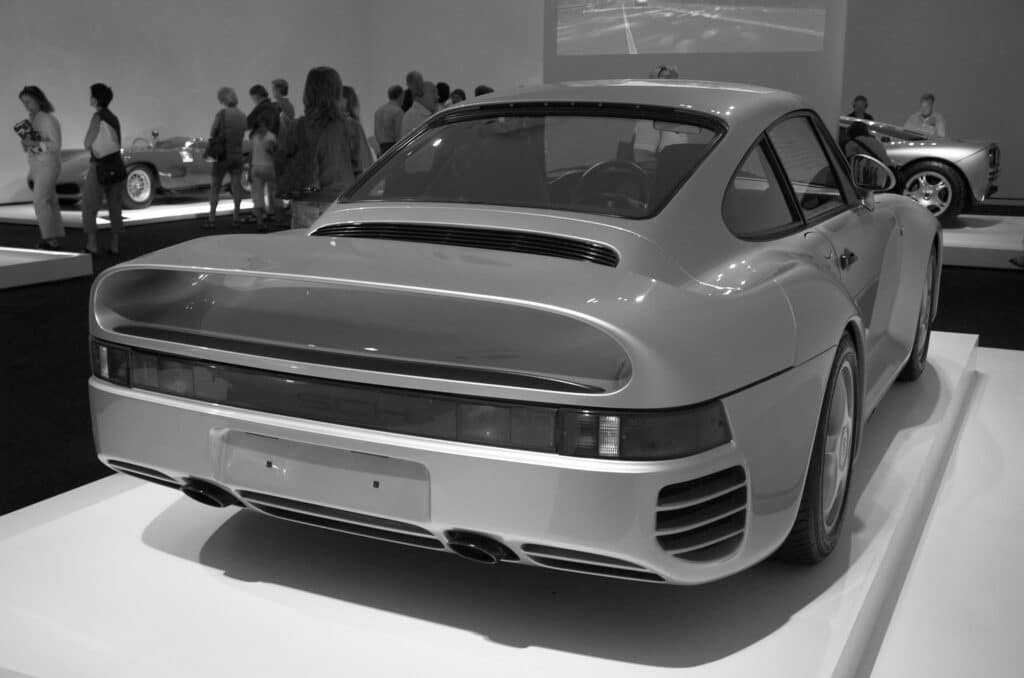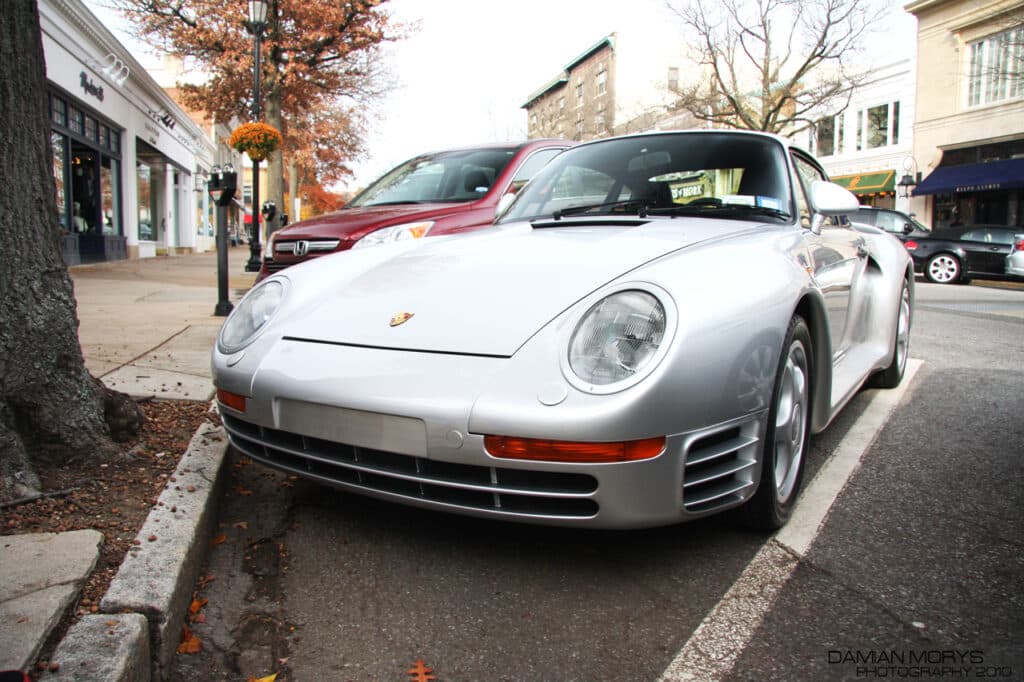There is no doubt that Porsche is one of the most influential and significant car makers of all time. Since its beginnings in the early 1930s, this Stuttgart-based manufacturer has combined innovative technology and sporty design to deliver a unique driving experience. The best example is the 911 range, which has always stayed true to its original concept, regardless of how different from the rest it may be. And with cars like Boxter or 928, Porsche proved it could make competitive cars in a more conventional form. Lastly, models like Panamera or Cheyenne widened the brand appeal by louring in drivers who wanted something both sporty and practical.
But among all cars Porsche has introduced throughout the years, the 959 is probably the most impressive and groundbreaking. At its time, this monster on wheels was the fastest road-legal vehicle in the world. But the sheer speed only tells a portion of the story, as there was much more to this particular car. And the rest of the amusing details and features will be revealed in this article.
Why was the Porsche 959 made in the first place?
Like many other great things in the automotive world, the Porsche at 959 owes its existence to motorsport. Or, more precisely, to the Group B series of FIA’s World Rally Championship. In the early 1980s, this was the place to be for many prestigious European car makers. With virtually no restrictions or limitations, this racing series allowed the manufacturers to showcase their capabilities. This was most evident when Audi turned the automotive world upside down with their legendary Quattro.
Predictably, Porsche, who had its fair share of victories in various motorsports competitions, wanted their piece of the action. Still, to go against the best of the best, they couldn’t just tweak one of their existing models to make it suitable for rally use. Instead, an entirely new car had to be designed and built from the ground up. And the idea was to create it based on the 911’s recognizable features – its shape and unique rear-engine configuration. But, given the intended role of a new car, there were some essential differences. This included an elaborate turbocharging system, lightweight construction, and an advanced four-wheel-drive system, among other innovations. As such, the new Porsche had true winning potential. Especially if the driver knows how to handle how a rear-engined vehicle behaves when pushed to the limit. But to compete in the rally, Porsche first had to build 200 road-legal cars which would be sold to private customers. And this is where 959 comes into play.
Porsche 959 – the looks
In many ways, the design of the newly-developed Porsche was based on the contemporary 911 model. And that’s why this car always looked like a beefed-up Elfer, which is how many saw it. Still, none of the add-ons weren’t there just for the show, as each had a vital purpose.

Those massive wheel arches had to be fitted, or otherwise, there wouldn’t be enough room for extra-wide tires. It’s much the same with big air vents in the bumpers, as these helped cool down the brakes. Still, 959’s most recognizable visual feature was the striking and unique-looking rear end, whose shape was made that way for one reason only – cooling. This was because the engine was mounted here, and a lot of air was needed to keep this turbocharged lump cooled down.

On the inside, despite its race-bred DNA, the Porsche 959 wasn’t a sparsely-equipped, stripped-out track tool. Instead, this car, in its road trim at least, had all sorts of creature comforts, including leather seats and air conditioning. Obviously, Porsche saw these things as necessities in a car priced at then-eye-watering $200,000.
Porsche 959 – the technology
There is no denying the Porsche 959, with its aggressive design, looked spectacular in every way. But being primarily a racing car, the most exciting stuff was hiding under the skin.
The engine it used was a race-derived version of the familiar air-cooled flat-six used in the 911s of the time. But unlike them, these engines had water-cooled cylinder heads, which was necessary for the intended high-performance application. While adding a turbocharger was already standard practice at the day, Porsche went one step further. Instead of simply strapping a pair of big turbos to the engine, their engineers incorporated sequential twin-turbochargers. By doing so, they’ve eliminated that dreaded turbo lag and ensured smooth power delivery. In the end, road-going cars would produce 450 horsepower and 369 pound-feet of torque.

The engine, powerful as it might’ve been, was only a part of what Porsche hoped to become a winning equation. As already proven by Audi and their Quattro, to win at rallying, the car has to have four-wheel drive. And the system Porsche had developed for this occasion was like nothing the world had seen before. This computer-controlled marvel could continuously change the torque distribution between the rear and front axles for maximum performance. But, unlike its counterparts, Porsche’s system could do this before the wheel would start slipping by anticipating its level of grip. This is astonishing even today, but back in the 80s, it was the equivalent of space-age technology.
Lastly, there was the revolutionary air suspension on which the 959 sat. With adjustable ride height and damping rate, this system made the car feel at home on every surface. And that would be extremely valuable when coping with one constant for every rally stage – ever-changing road conditions.
How did Porsche 959 sell
Porsche 959, thanks to its looks and array of high-tech gadgets, was an instant hit among the rich and famous. Boris Becker, Daley Thompson, and Martina Navratilova – are just some of those who have fallen for this wonder on wheels. Many car enthusiasts in the US were, obviously, keen on having their own 959 in the garage. There was, however, a problem in the form of strict import regulations. To be sold there, every model must meet various safety and emission requirements, which, at the time, were much more rigorous than those in Europe. And because they were going to build only 200 cars, Porsche couldn’t be bothered with all that. As a result, the 959 was never officially sold in the US.
Today, however, all Porsche 959s are over 25 years old, which effectively makes them oldtimers. And as such, they don’t have to meet strict regulations anymore, meaning they can be legally imported into the US.
Porsche 959 – the legacy
Odd as it may sound, the 959 was, in a way, a massive failure for Porsche. The fact is that this car was primarily made to compete in the World Rally Championship. And by the time this racer fulfilled all the requirements, Group B, in which it would participate, got canceled. This left Porsche and many other manufacturers hanging out to dry, with super-fast racing cars and no place to use their potential. Sure, the 959 won the 1986 Paris-Dakar Rally and had its successes at the 24 Hours of Le Mans. This, however, was a mere shadow of the glory Audi Quattro or Lancia 037 got for their victories.

But despite these initial disappointments, Porsche 959 did have a profound effect on all future supercars. It proved that there is much more to a fast car than a massive, powerful engine. With its elaborate drivetrain and complex suspension, the Porsche 959 would go through bends at seemingly impossible speeds. And that made it incredibly quick in real-life situations, be it on a track or twisty road. From there on, everybody knew that to go really fast, sophisticated technology all around would be needed.
Porsche 959 – in short
Porsche 959 is a german-made sports car manufactured between 1986 and 1993. Initially, approximately 200 examples were to be made, as this was needed to meet the FIA’s requirement for entering the World Rally Championship. But due to the high interest, Porsche ended up making a total of 345 cars. With its smooth power delivery, groundbreaking four-wheel-drive system, and innovative air-ride suspension, the 959 was an engineering masterpiece. And as such, it laid the foundations for all future supercars, with most future models following the recipe set by this legendary Porsche.





